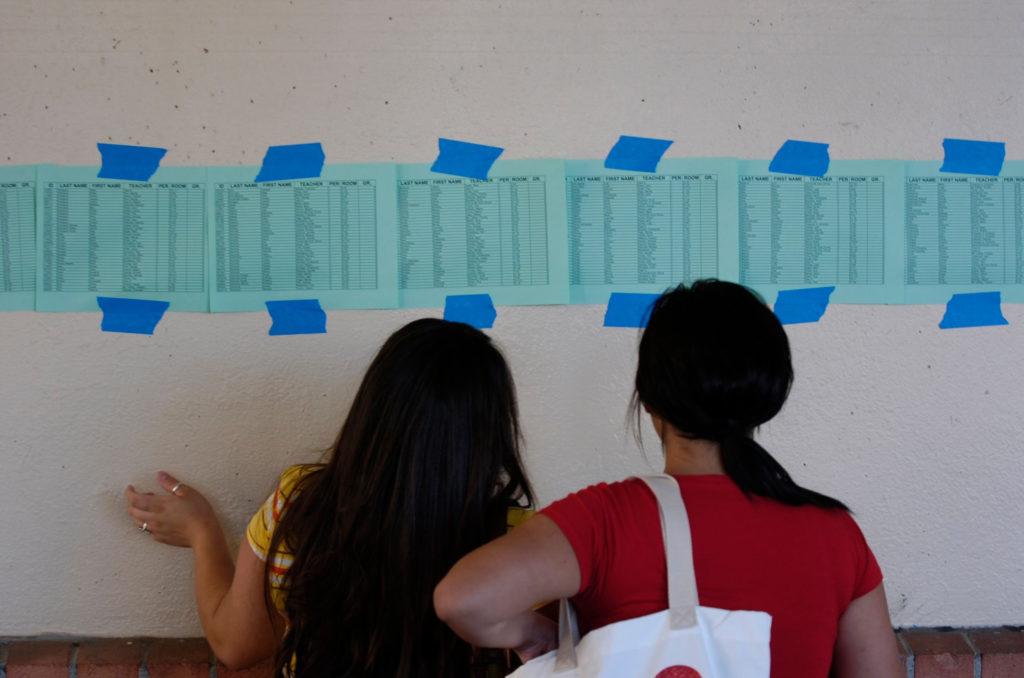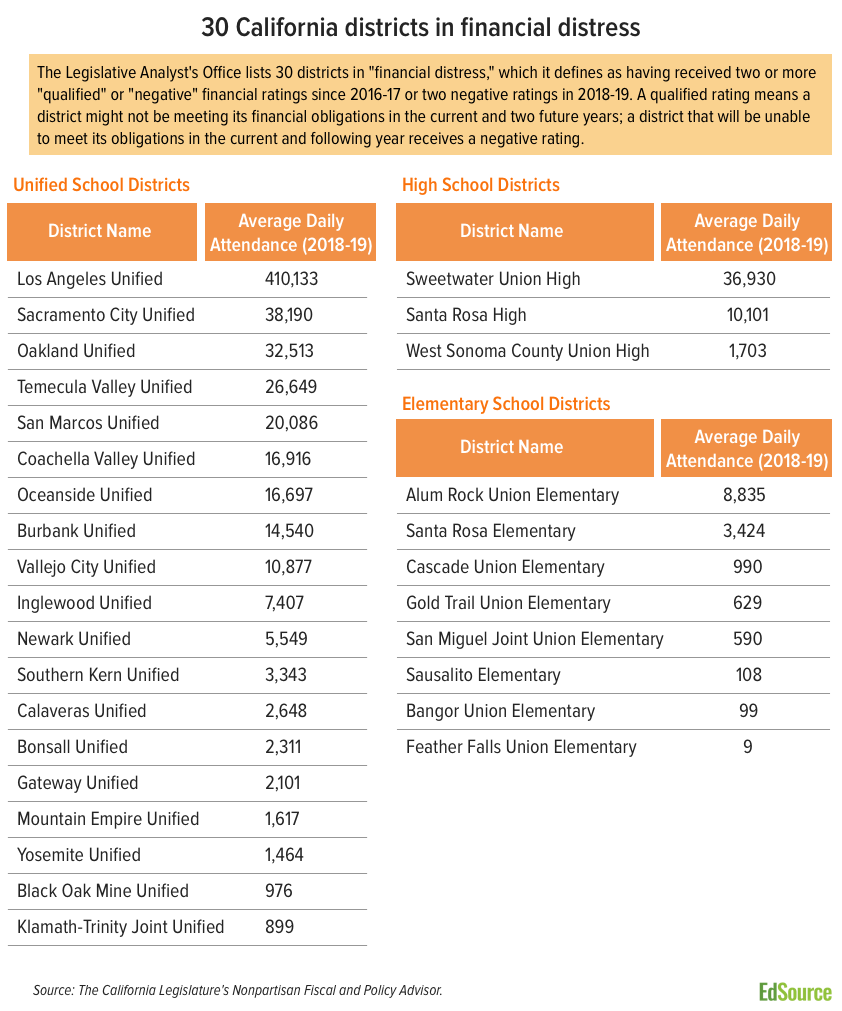
Black teachers: How to recruit them and make them stay

Lessons in higher education: What California can learn

Keeping California public university options open

Superintendents: Well-paid and walking away

The debt to degree connection

College in prison: How earning a degree can lead to a new life

A historically low proportion of school districts in California currently are in fiscal distress. But with most districts facing declining enrollments and escalating costs, the Legislative Analyst’s Office is suggesting that the Legislature give districts more financial relief in next year’s state budget.
The recommendation for using one-time funding to help districts pay down their pension and retiree health liabilities is in a report issued Tuesday. It is at odds with the spending priorities that Gov. Gavin Newsom proposed earlier this month in his 2020-21 budget for K-12 schools. Newsom is proposing to target about half of the expected increase in school funding for teacher workforce initiatives, for assistance to low-performing schools and districts and for expanding community schools, which provide comprehensive health and academic services, primarily for low-income children.
The LAO didn’t criticize Newsom’s choices; instead it said relief from cost pressures deserves top priority. “Of all the Legislature’s options for one‑time initiatives, we believe making supplemental pension payments would provide the greatest sustained fiscal benefit for districts,” the report said.
Paying down districts’ debts would put districts in a better long-term position, since in coming years they can expect smaller funding increases than they have had, post-recession, the LAO said.
Since 2013-14, per-pupil funding has grown 5.9 percent annually, about 50 percent higher than the historic average for California. Districts used the money mostly to hire support staff, such as counselors and teacher aides for students with disabilities, and to increase teacher pay beyond inflation, although there is a big range among the state’s 1,000 districts. The far majority of districts, for now, are financially stable, the LAO said.
As a result, there are only about 30 districts identified with severe budget problems — the largest being Los Angeles Unified, Sacramento City Unified, Oakland Unified and Sweetwater Union High School District, near San Diego. The first three dealt with divisive teacher strikes last year; Sweetwater is facing massive cuts following suspected fraud and mismanagement.
What the distressed districts have had in common, the report said, are tensions with staff, a turnover in top administrators and a larger than average decline in enrollment and increase in retiree health benefits.
But most districts face some cost pressures, the LAO said. While enrollment is growing in Kern County and a few areas, most districts have seen a drop in enrollment, which results in less state revenue. And areas with the biggest declines — Los Angeles, Orange and Santa Clara counties – will see a continued migration of families moving out in the coming decade, the LAO said. At the same time, the proportion of students with disabilities, especially autism, and payments for retiree pensions and retiree health benefits will rise faster than inflation statewide.
In the 2019-20 state budget, Newsom directed more than $3 billion from the state’s General Fund to buy down districts’ long-term pension liabilities and to help with immediate payments they owed to CalSTRS, the teacher pension fund. About $400 million of that relief is left over to help in next year’s proposed budget.
But districts’ pension payments to CalSTRS and CalPERS will rise $800 million next year all the same. And Newsom is not proposing to tap the General Fund for K-12 for next year. He would fund only the projected 4.1 percent increase through Proposition 98, the formula that determines the minimum state revenue that goes to K-12 and community colleges.
Newsom is proposing to significantly increase and equalize funding for districts for students with disabilities, which the LAO agrees with. But the $1.2 billion increase for the Local Control Funding Formula, the main source of districts’ base funding within Prop. 98, would barely cover districts’ obligations, and for some districts, not even that.
The LAO recommends using one-time money either as a supplemental pension payment to lower long-time debt or to give districts a choice of which liability — pension, health care or retiree health obligations — to lower.
The LAO offers no specific action to help districts in distress, other than for the state and county offices of education to continue working with them to improve their budget practices. It advises against giving them any extra financial help.
In its audit last fall of Sacramento City Unified’s troubled finances, State Auditor Elaine Howle urged new legislation to strengthen county offices’ authority to intervene in financially struggling districts. They would be able to prevent districts from approving expenditures, potentially including salary contracts, that they could not afford.
The LAO hasn’t taken a position yet on that and other measures that might be needed to ward off financial problems.


Panelists discussed dual admission as a solution for easing the longstanding challenges in California’s transfer system.

A grassroots campaign recalled two members of the Orange Unified School District in an election that cost more than half a million dollars.

Legislation that would remove one of the last tests teachers are required to take to earn a credential in California passed the Senate Education Committee.

Part-time instructors, many who work for decades off the tenure track and at a lower pay rate, have been called “apprentices to nowhere.”
Comments (3)
Comments Policy
We welcome your comments. All comments are moderated for civility, relevance and other considerations. Click here for EdSource's Comments Policy.
Mary Johnson, Parent-U-Turn 4 years ago4 years ago
I disagree with Governor Newson and LAO, More money should be target for programs that inspire basic learning skills such as reading, writing, and math. We have students that are graduating with 1.5 GPA that can't read or do basic math. Teachers are getting paid on the back of struggling students. Teachers are part of the equation but not answer to all that is wrong with education. Some of the money for teachers short … Read More
I disagree with Governor Newson and LAO, More money should be target for programs that inspire basic learning skills such as reading, writing, and math. We have students that are graduating with 1.5 GPA that can’t read or do basic math. Teachers are getting paid on the back of struggling students. Teachers are part of the equation but not answer to all that is wrong with education. Some of the money for teachers short should be share with Teachers ED programs at local universities because the young teachers aren’t prepared properly to teach in inner cities. Teacher ED Programs lack giving Novice teacher exposure to the real condition of Inner Cities Schools. The majority of their learning comes from reading books and lectures from professors. More teachers not training and prepare to lead to more student’s failure. Our students need more reading specialists and programs and less google dot.
Replies
Dan Plonsey 4 years ago4 years ago
The problem is the Governor has allocated $1.2 billion, which sounds generous, but paying off the big pension funds (CalSTRS and CalPERS) will cost $0.8 billion. We are repaying these funds not because of anything teachers did or are doing, but because these funds lost enormous value because of the greed which caused the Crash of '09. Basically, billionaires robbed teachers' pension funds to get even richer, and now taxpayers are having to chip in … Read More
The problem is the Governor has allocated $1.2 billion, which sounds generous, but paying off the big pension funds (CalSTRS and CalPERS) will cost $0.8 billion. We are repaying these funds not because of anything teachers did or are doing, but because these funds lost enormous value because of the greed which caused the Crash of ’09.
Basically, billionaires robbed teachers’ pension funds to get even richer, and now taxpayers are having to chip in to partially restore those funds. The “argument” over how to use the remaining $400 million the Governor has allocated is a deliberate distraction from the reality which is education in CA is underfunded by over $30 billion, so this bit of money (1% of what is needed) is a drop in the bucket. The only real issues in education are: 1) Underfunding 2) Student poverty makes learning very difficult, so you’ve got to fix poverty first.
Rob Wood 4 years ago4 years ago
With the increased capability for students to get their own education outside of the formal public ed system via a myriad of opportunities from Khan Academy and untold numbers of YouTube subject offerings, all for free, more and more will just walk away leaving a funding system based on butts in seats to only fund the lower echelon of students. I highly suggest reading "Disrupting Class" by Clayton Christensen and "The One World School House, … Read More
With the increased capability for students to get their own education outside of the formal public ed system via a myriad of opportunities from Khan Academy and untold numbers of YouTube subject offerings, all for free, more and more will just walk away leaving a funding system based on butts in seats to only fund the lower echelon of students. I highly suggest reading “Disrupting Class” by Clayton Christensen and “The One World School House, Education Reimagined” by Sal Khan. Tailoring a school in terms of the less capable or disadvantaged leaves the more self-motivated students out in the cold to become bored and frustrated. I see them saying that they can get together at the local mall food court with WIFI and do far better on their own tailoring their education to meet their learning styles collaboratively with their peers.